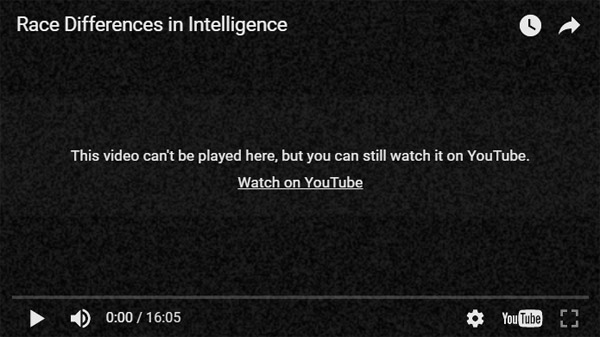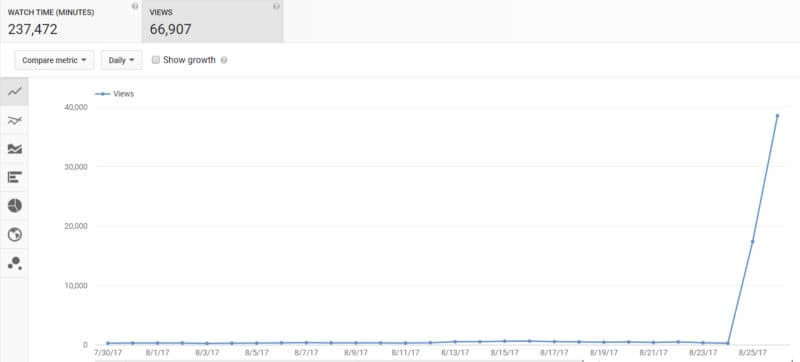Am I the First Victim of YouTube’s New Censorship?
Jared Taylor, American Renaissance, August 28, 2017
YouTube has just begun its widely reported campaign against “extremist” videos, and one of mine may have been the very first to be quarantined. In a new strategy that falls short of outright removal — YouTube does that, too — the company punishes “borderline” videos by making them unsearchable, disabling comments or embedding, and never suggesting them to viewers. The only way to get to them is through a direct link posted on a different website. Then you are warned that the video “has been identified by the YouTube community as inappropriate or offensive to some audiences.” YouTube also disables view counts and up- or down-votes, so you have no idea how widely seen or favorably received the video has been.

The view when a user tries to play an embedded version of my video.
This is how YouTube explains its censorship:
YouTube . . . prohibits content intended to recruit for terrorist organizations, incite violence, celebrate terrorist attacks, or otherwise promote acts of terrorism. Some borderline videos, such as those containing inflammatory religious or supremacist content without a direct call to violence or a primary purpose of inciting hatred, may not cross these lines for removal. Following user reports, if our review teams determine that a video is borderline under our policies, it may have some features disabled.
I’m glad YouTube doesn’t think I’m promoting terrorism, but apparently I’m pretty close. You can watch the video and see if you agree. I think you will find it is a sober, factual discussion of the evidence for the view that the races differ in average intelligence, and that there is a significant genetic contribution to that difference. The video even has a list of references at the end. It is hardly “inflammatory” — it is a recitation of facts — and if it is “supremacist,” it would have to be “yellow supremacist” because it notes that Asians have higher average IQs than whites.
It is a terrible precedent when a huge company like YouTube — with the “help” of groups such as the No Hate Speech Movement and the Anti-Defamation League — starts deciding which facts to promote and which to suppress. My video is a perfect example of what should be welcome in “the market place of ideas.” If I’m wrong, refute me. YouTube doesn’t see it that way. It gave my video the leper treatment because it doesn’t want dissent on the subject of race and IQ. Is this the kind of society we want?
I have been gratified by the number of people who, like me, deplore YouTube’s attempt at to be the gate-keeper of ideas. Julian Assange — who knows a thing or two about censorship — called the suppression of my video “a clear attempt at social engineering.”
What’s interesting about the new method deployed is that it is a clear attempt at social engineering. It isn’t just turning off the ads.
— Julian Assange 🔹 (@JulianAssange) August 26, 2017
Paul Joseph Watson, who lost a six-figure cash flow when YouTube arbitrarily stopped his ad revenue, noted that “the first video to be censored as ‘offensive’ by YouTube is political.” He has a point: Violence, obscenity, vulgarity, and the crudest forms of vituperation are not “offensive,” but facts about race are.
The first video to be censored as “offensive” by YouTube is political. Imagine my shock. https://t.co/7WgdVZ5459 pic.twitter.com/Mc0WU3JhhX
— Paul Joseph Watson (@PrisonPlanet) August 26, 2017
Popular YouTube commentator Lauren Southern also hit the mark: “Your channel is next,” she wrote. “Speak up.”
You can’t find this video. You can’t like it. You can’t comment. You can’t go to the creators channel.
Your channel is next. Speak up. pic.twitter.com/RBdt3aQ3r4
— Lauren Southern (@Lauren_Southern) August 26, 2017
Tweets like these have been retweeted thousands and thousands of times.
It is all very well to argue that YouTube is a private company and has the right to ban any content it likes, but YouTube is essentially a monopoly; it has no real competitors. It therefore has at least a moral obligation serve the public — not preen itself in public — and to ban only those videos that violate obscenity, defamation, incitement, and other legal standards.
This video actually has a curious history; it was banned outright by YouTube before reappearing and then being cast into its current state of limbo.
My staff first posted the video in 2013, but in January 2014, YouTube took it down without warning, without explanation, and with no way to appeal. It had been a success. It got over 150,000 views and hundreds of comments. We made a few cosmetic changes and uploaded it again to YouTube, where, until two days ago, it gathered an additional 300,000 views, nearly 6,000 likes, and only 2,000 dislikes.
The leper treatment has had a predictable result. Many people want to know what YouTube now considers “inflammatory religious or supremacist content,” so I have picked up another 70,000 views in just the two days since the video was banned. This won’t always be the case, of course. Many worthy videos will be cast into the outer darkness only because YouTube and its staff of blue noses were “offended.”

What is YouTube afraid of? If I am obviously wrong, no one will pay attention. If I left something out or misinterpreted something, those who are right will correct me. In fact, there is a lively debate here, among people who do dispute some of my facts, and who are cursing YouTube for cutting off comments. They can’t correct me!
When YouTube announced its new policy, it promised to send a notice to offenders and give them the right to appeal. I have appealed; I’m still waiting for a reply.
YouTube reminds me of what a perhaps apocryphal bishop’s wife said when she first heard of Darwin’s theory of evolution: “Let us hope it is not true, but if it is, let us pray it does not become widely known.” Our tech masters think they are oh-so-progressive and liberated; they are more like Victorians.















